Sweet Corn IPM Newsletter No. 7- August 14, 2020
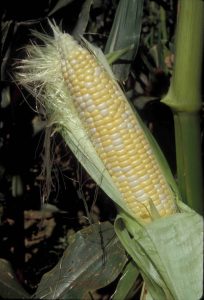
Sweet Corn IPM Newsletter No. 7- August 14, 2020
Click on photos to enlarge.
HIGHEST CORN EARWORM, FALL ARMYWORM NUMBERS THIS SEASON
But Counts Variable Around the State; North & West See Mostly Lower Numbers
SITUATION
A very hot, dry week has advanced later corn plantings, resulting in earlier than expected maturity for some fields. Many fields are experiencing a second period of drought conditions, while others have picked up enough stray showers to maintain adequate soil moisture. Major pest populations are highly variable this week, with some sites having the highest pressure of the season while others are seeing less than last week. Situations like this highlight the importance of monitoring pests in your own fields, as conditions can vary greatly within just a few miles.
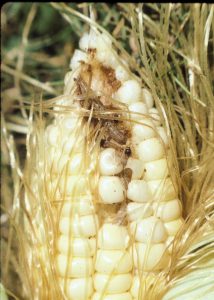
European Corn Borer:
Most fields are now in silk or beyond. So, if they are under a spray interval for earworm or armyworm, those sprays should provide control of larval feeding on foliage and tassels. Larval feeding injury was not over the 15% control threshold for pre-silking corn at any location scouted this week. Moth counts were over the weekly threshold of five for silking corn in Dayton, Monmouth, and Sabattus, indicating a second generation emerging at these sites.
Corn Earworm:

Moth captures climbed to season high numbers at some locations leading to an uncommon recommendation for a three-day spray interval for silking corn in New Gloucester where the count was over 100 moths. A four-day interval was recommended in Auburn, Biddeford, Cape Elizabeth, Charleston, Dayton, Lewiston, and Wells. A five-day spray interval was recommended in Corinth, Farmington, Levant, and Monmouth. A six-day spray interval was recommended in Oxford, and Sabattus.
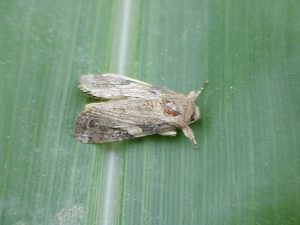
Fall Armyworm (FAW):
Moth captures were variable from site to site this week, with over 100 moths caught in Biddeford, but no moths at some locations further north. Counts exceeded the three-per-week threshold for silking corn in: Auburn, Biddeford, Cape Elizabeth, Dayton, Lewiston, New Gloucester, Oxford, Poland Spring, Sabattus, and Wells. Only the Poland Spring site was not under a spray interval for corn earworm, so a spray for FAW on silking corn was recommended. Fall armyworm larval feeding damage on pre-silking corn exceeded the 15% threshold in Biddeford and Dayton.
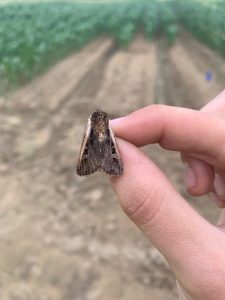
Western Bean Cutworm:
Moths counts were lower at nearly all locations this week, but still at threatening levels, including; Auburn (23), Biddeford (12), Cape Elizabeth (28), Dayton (13), Lewiston (7), Farmington (1), Monmouth (2), New Gloucester (57), Oxford (35), Poland Spring (12), Sabattus (3), and Wells (11). All locations, except Poland Spring, are spraying for corn earworm, which should protect corn from western bean cutworm.
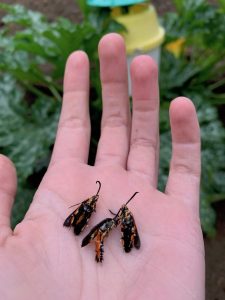
Squash vine borer moths were caught in pheromone traps in Biddeford (1), Oxford (1) and Wells (9) this week. Only the Wells site was over the threshold of five moths per week to protect squash and pumpkins.
Spotted Wing Drosophila:
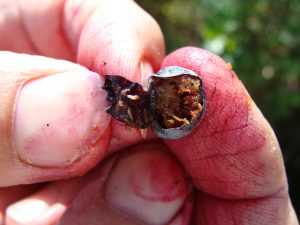
Fly trap counts continue to increase at most sites this week; the threat level is very high for any ripening fall raspberries, strawberries, blackberries and blueberries. For more information visit our website
Sincerely,
David T. Handley
Vegetable & Small Fruit Specialist
Highmoor Farm Pest Mgmt. Unit
P.O. Box 179 17 Godfrey Drive
52 U.S. Route 202 Orono, ME 04473
Monmouth, ME 04259 1.800.287.0279
207.933.2100
| Location | CEW
Moths |
ECB
Moths |
FAW
Moths |
%Feeding
Damage |
Recommendations / Comments |
|---|---|---|---|---|---|
| Auburn | 44 | 0 | 17 | 3% | 4-day spray interval for all silking corn |
| Biddeford | 42 | 1 | 128 | 42% | 4-day spray interval for all silking corn |
| Cape Elizabeth | 28 | 0 | 21 | 13% | 4-day spray interval for all silking corn |
| Charleston | 16 | 0 | 0 | 4-day spray interval for all silking corn | |
| Corinth | 4 | 0 | 0 | 5-day spray interval for all silking corn | |
| Dayton | 34 | 12 | 27 | 17% | 4-day spray interval for all silking corn |
| Farmington | 4 | 0 | 0 | 5-day spray interval for all silking corn | |
| Lewiston | 21 | 0 | 13 | 4-day spray interval for all silking corn | |
| Levant | 6 | 0 | 0 | 5-day spray interval for all silking corn | |
| Monmouth | 4 | 6 | 0 | 5-day spray interval for all silking corn | |
| New Gloucester | 112 | 0 | 33 | 14% | 3-day spray interval for all silking corn |
| Oxford | 2 | 0 | 78 | 3% | 6-day spray interval for all silking corn |
| Palmyra | 0 | 0 | 0 | 2% | No spray recommended |
| Poland Spring | 1 | 3 | 6 | One spray on all silking corn for FAW | |
| Sabattus | 2 | 21 | 5 | 6-day spray interval for all silking corn | |
| Wells I | 24 | 0 | 7 | 4-day spray interval for all silking corn | |
| Wells II | 96 | 0 | 21 | 13% | 4-day spray interval for silking corn |
CEW: Corn earworm (Only fresh silking corn should be sprayed for this insect.)
ECB: European corn borer
FAW: Fall armyworm
| Moths caught per week | Moths caught per night | Spray interval |
|---|---|---|
| 0.0 to 1.4 | 0.0 to 0.2 | No spray |
| 1.5 to 3.5 | 0.3 to 0.5 | Spray every 6 days |
| 3.6 to 7.0 | 0.6 to 1.0 | Spray every 5 days |
| 7.1 to 91 | 1.1 to 13.0 | Spray every 4 days |
| More than 91 | More than 13 | Spray every 3 days |
Thresholds apply only to corn with exposed fresh silk. Lengthen spray intervals by one day if the maximum daily temperature is less than 80°F.
European Corn Borer Thresholds
Whorl stage: 30% or more of plants scouted show injury.
Pre-tassel-silk: 15% or more of plants scouted show injury.
Silk: 5 or more moths caught in pheromone traps in one week.
IPM Web Pages:
Where brand names or company names are used, it is for the reader’s information. No endorsement is implied nor is any discrimination intended against other products with similar ingredients. Always consult product labels for rates, application instructions and safety precautions. Users of these products assume all associated risks.
The University of Maine is an equal opportunity/affirmative action institution.
